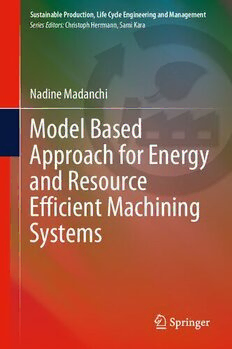Table Of ContentSustainable Production, Life Cycle Engineering and Management
Series Editors: Christoph Herrmann, Sami Kara
Nadine Madanchi
Model Based
Approach for Energy
and Resource
Efficient Machining
Systems
Sustainable Production, Life Cycle Engineering
and Management
SeriesEditors
ChristophHerrmann,Braunschweig,Germany
SamiKara,Sydney,Australia
SPLCEM publishes authored conference proceedings, contributed volumes and
authoredmonographsthatpresentcutting-edgeresearchinformationaswellasnew
perspectives on classical fields, while maintaining Springer’s high standards of
excellence,thecontentispeerreviewed.Thisseriesfocusesontheissuesandlatest
developments towards sustainability in production based on life cycle thinking.
Modern production enables a high standard of living worldwide through products
and services. Global responsibility requires a comprehensive integration of
sustainable development fostered by new paradigms, innovative technologies,
methods and tools as well as business models. Minimizing material and energy
usage, adapting material and energy flows to better fit natural process capacities,
and changing consumption behaviour are important aspects of future production.
A life cycle perspective and an integrated economic, ecological and social
evaluationareessentialrequirementsinmanagementandengineering.
**IndexedinScopus**
To submit a proposal or request further information, please use the PDF
Proposal Form or contact directly: Petra Jantzen, Applied Sciences Editorial,
email:[email protected]
Moreinformationaboutthisseriesathttp://www.springer.com/series/10615
Nadine Madanchi
Model Based Approach
for Energy and Resource
Efficient Machining Systems
NadineMadanchi
InstituteofMachineToolsandProduction
Technology
TechnischeUniversitätBraunschweig
Braunschweig,Germany
ISSN2194-0541 ISSN2194-055X (electronic)
SustainableProduction,LifeCycleEngineeringandManagement
ISBN978-3-030-87539-8 ISBN978-3-030-87540-4 (eBook)
https://doi.org/10.1007/978-3-030-87540-4
©TheEditor(s)(ifapplicable)andTheAuthor(s),underexclusivelicensetoSpringerNature
SwitzerlandAG2022
Thisworkissubjecttocopyright.AllrightsaresolelyandexclusivelylicensedbythePublisher,whether
thewholeorpartofthematerialisconcerned,specificallytherightsoftranslation,reprinting,reuse
ofillustrations,recitation,broadcasting,reproductiononmicrofilmsorinanyotherphysicalway,and
transmissionorinformationstorageandretrieval,electronicadaptation,computersoftware,orbysimilar
ordissimilarmethodologynowknownorhereafterdeveloped.
Theuseofgeneraldescriptivenames,registerednames,trademarks,servicemarks,etc.inthispublication
doesnotimply,evenintheabsenceofaspecificstatement,thatsuchnamesareexemptfromtherelevant
protectivelawsandregulationsandthereforefreeforgeneraluse.
Thepublisher,theauthorsandtheeditorsaresafetoassumethattheadviceandinformationinthisbook
arebelievedtobetrueandaccurateatthedateofpublication.Neitherthepublishernortheauthorsor
theeditorsgiveawarranty,expressedorimplied,withrespecttothematerialcontainedhereinorforany
errorsoromissionsthatmayhavebeenmade.Thepublisherremainsneutralwithregardtojurisdictional
claimsinpublishedmapsandinstitutionalaffiliations.
ThisSpringerimprintispublishedbytheregisteredcompanySpringerNatureSwitzerlandAG
Theregisteredcompanyaddressis:Gewerbestrasse11,6330Cham,Switzerland
Acknowledgments
This book has been written in the context of my work as a research engineer at
theChairofSustainableManufacturingandLifeCycleEngineeringattheInstitute
of Machine tools and Production Technology (IWF) at the Technische Universität
Braunschweig.Herewith,Iwouldliketothankallthosewhohavesupportedmein
thecreationofthisbook.
First of all, I specially thank Prof. Dr.-Ing. Christoph Herrmann as chair and
co-director of the institute for providing an excellent working environment with
great opportunities and freedom as well as his continuous support over the years.
Furthermore,IthankProf.Dr.SteveSkerlosoftheUniversityofMichiganandProf.
Dr.ManbirSodhioftheUniversityofRhodeIslandfortheirpositivefeedbackand
theevaluationofthisbookaswellasProf.Dr.-Ing.ThomasVietoroftheTechnische
UniversitätBraunschweigforthecoordinationofthedissertationcommittee.Iwould
further like to thank Prof. Dr. Timothy Gutowski of the Massachusetts Institute of
TechnologyforhisgreatsupportduringmyresearchstayatMIT,whichhadastrong
impactonthiswork.
ManythanksgotoallmyformercolleaguesattheIWFforcreatingtheexcep-
tionally collaborative and positive atmosphere that I could enjoy while working at
thisinstitute.Throughtheintensivetimeofthelastyearswithexcitingbusinesstrips,
conferencesandalotoftimespentattheinstitute,manyofyouhavealsobecome
close friends. In particular, I want to emphasize great gratitude to Dr.-Ing. Marius
Winter who already inspired me as a master student for the topics of sustainable
machining and cutting fluids and from whose guidance and ideas I have benefited
until the successful completion of this book. Further, special thanks go to Prof.
Dr.-Ing. Sebastian Thiede the former head of the research group for his insightful
comments and reviewing the book. Another great thank you goes to Robar Arafat
forhissupportbutalsohisenthusiasmforthecommonresearchtopics.Representa-
tiveforallthestudentsthatIhavesupervisedintheirthesesworksorassistantjobs
I would like to thank Benjamin Lamottke, Jonas Heinecke, Manuel Mutz, Tobias
Rahn,andWenTangfortheirgreatsupportandwork.
Above all, I am grateful to my parents. Grateful for their encouragement, their
unwaveringsupportinallcircumstances,andforalltheopportunitiestheyhavemade
v
vi Acknowledgments
possibleforme.Andfinally,IwouldliketothankRomanforjointworkingsessions
in the evenings, weekends, or vacations and especially for everything beyond the
dissertationprocess.
Hamburg,Germany NadineMadanchi
February2020
Contents
1 Introduction ................................................... 1
1.1 MotivationandScope ....................................... 1
1.2 ResearchObjectiveandApproach ............................ 4
References ..................................................... 6
2 MachiningSystemsandImpactofCuttingFluids ................. 9
2.1 ElementsandInteractionsinMachiningSystems ................ 9
2.2 Classification,FunctionsandStrategiesofCuttingFluids ......... 12
2.3 DescriptionofRelevantElementsoftheMachiningSystem ...... 17
2.3.1 MachiningProcessesandToolPreparation ............... 17
2.3.2 CuttingFluidSystem ................................. 20
2.3.3 ExhaustAirSystem .................................. 30
2.3.4 WorkpieceandScrapTreatmentSystem ................. 33
2.4 PeripheralSystemsWithinMachiningProcessChains ........... 35
2.5 ModelingofMachiningSystems .............................. 37
2.5.1 ModelingApproach .................................. 37
2.5.2 ModelingofEnvironmental,EconomicandFunctional
PerformanceIndicators ............................... 39
2.6 PreliminaryConclusion ..................................... 42
References ..................................................... 43
3 StateofResearch ............................................... 51
3.1 ProcedureandOverviewofResearchApproaches ............... 51
3.2 Criteria for the Comparative Evaluation of Research
Approaches ................................................ 57
3.3 EvaluationofSelectedApproaches ............................ 62
3.4 DerivationofResearchDemand .............................. 67
References ..................................................... 68
4 ConceptDevelopment .......................................... 73
4.1 FrameworkforConceptDevelopment ......................... 73
4.1.1 DefinitionofObjectivesandRequirements .............. 73
vii
viii Contents
4.1.2 ConceptStructure .................................... 75
4.2 ModelingofMachiningSystemElements ...................... 77
4.2.1 DescriptionofProcedure .............................. 78
4.2.2 MachiningProcessModel ............................. 83
4.2.3 PeripheralSubsystemModel ........................... 102
4.2.4 MultipleMachiningSystemsandProcessChains ......... 118
4.2.5 ModelOverviewandConnection ....................... 120
4.3 Environmental,EconomicandTechnologicalImpact ............ 122
4.4 ImprovementMeasures ...................................... 129
4.4.1 DescriptionofMeasures .............................. 130
4.4.2 ImpactVisualization .................................. 132
4.5 ConceptImplementation ..................................... 133
References ..................................................... 136
5 ExemplaryApplicationoftheConcept ........................... 141
5.1 ApplicationtoaMachiningSystem ........................... 141
5.1.1 AnalyzingandEvaluatingaMachiningSystem ........... 141
5.1.2 Impact of Process Parameters and Cutting Fluid
Strategies ........................................... 145
5.1.3 ApplicationofImprovementMeasures .................. 149
5.1.4 DemonstrationofFurtherPossibleMeasures ............. 153
5.2 ApplicationtoaProcessChain ............................... 156
5.2.1 PlanningandEvaluatingaProcessChain ................ 157
5.2.2 ApplicationofFurtherImprovementMeasures ........... 159
5.3 OverviewandComparisonofImprovementMeasures ........... 161
References ..................................................... 163
6 Summary,DiscussionandOutlook ............................... 165
6.1 Summary .................................................. 165
6.2 Discussion ................................................ 167
6.3 Outlook ................................................... 169
References ..................................................... 170
Appendix ......................................................... 171
Symbols and Abbreviations
UpperCaseSymbols
A Surfacearea
A Surfaceareaofcleaningtank
cm
A Surfaceareaofuncutchip
cu
A Cuttingfluidjetarea
j
A Outletareaofthenozzle
n
A Surfaceareaoftheworkpiece
ws
C Constanti
i
C Radiationcoefficient
r
CI Cuttingfluidequivalentcosts
cf
CI Energyrelatedequivalentcosts
e
CI Machinetoolandlaborrelatedcosts
ml
CI Machiningsystemrelatedcosts
ms
CI Toolrelatedcosts
t
CO2,cf,p EquivalentCO2impactduetoproducedcuttingfluid
CO2,cf,d EquivalentCO2impactduetodisposedcuttingfluid
CO2,e EquivalentCO2impactduetoenergy
CO2,t EquivalentCO2impactduetotools
D Millingtooldiameter
E Relativeerror
E Energydemandduetocutting/processing
c
E Energydemandduetocleaning
cm
E Energydemandduetocooling
cu
E Energydemandduetode-oiling
de
E Energydemandduetostandbystage
s
E Energydemandduetotoolusage
t
EER Energyefficiencyratio
EI CuttingfluidequivalentCO impact
cf 2
EI EnergyrelatedequivalentCO impact
e 2
ix

